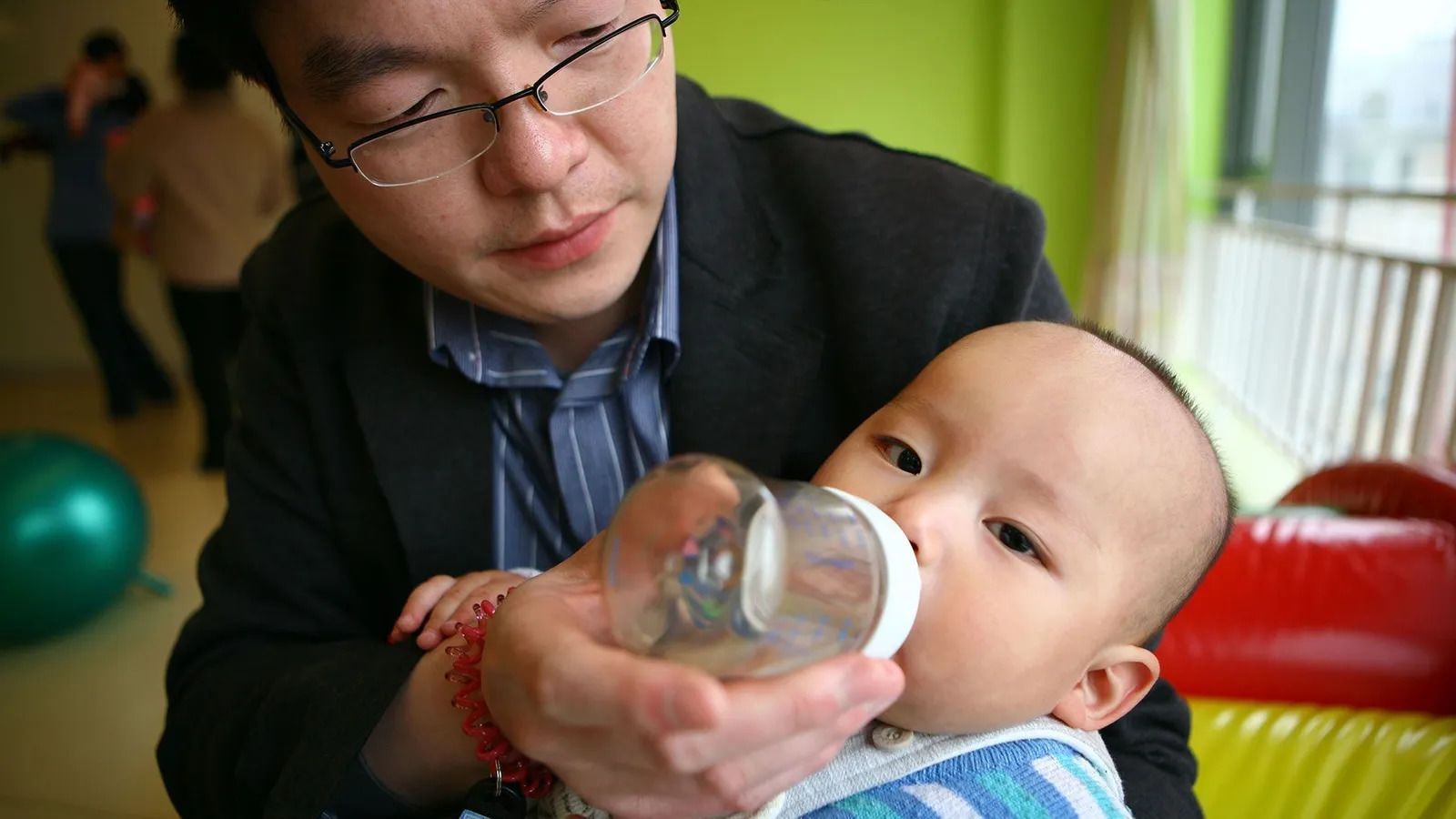The surprising science of breast milk
Throughout the first year of their lives, I breastfed my two children without the use of infant formula. Breast milk has been shown to be an ideal source of nutrition for babies, with many benefits for their developing brains, immune systems and digestive tracts, and I was glad to be able to offer them that boost. But when I had my blood tested for persistent toxic chemicals while researching a book on pollution, I discovered that some pesticides banned more than 40 years ago could still be detected in my body. There is also evidence that low levels of some chemical contaminants can be passed from a mother into her breast milk. Yet formula milk is also prone to contamination with toxic chemicals or potentially harmful bacteria, which have led to high-profile food scares and recalls in recent years.
It made me wonder what's really in the first foods our children consume – from the most beneficial ingredients, to hidden, undesirable or even toxic ones. And given what we know about some of the dangers, what can be done to improve all the available options for babies, be they breast- or formula-fed, and offer them the best possible start in life?
The milk that changes every day
Breast milk is considered the top choice for a baby's first food (the World Health Organization recommends that infants should be exclusively breastfed for the first six month of life). It mainly consists of water, fat, protein, as well as vitamins, minerals, digestive enzymes and hormones. It is rich in maternal antibodies, and has anti-infective properties. Breast milk is also a dynamic, adaptable food – it is fattier in the afternoon and evening than in the morning, for example. It also varies during a feed. When the baby latches onto the breast, the first gush of milk, or foremilk, is thin and high in lactose, making it thirst-quenching and easy to drink. The so-called hindmilk that follows is creamier and fattier, making it more filling. This dynamic aspect is one reason why breast milk is hard to replicate, despite considerable advances in the quality of infant formula.
"Human milk varies over the course of lactation, over the course of a day, from the start to the end of the feed, and to some extent on maternal factors such as her diet," says Mary Fewtrell, a professor of paediatric nutrition at University College London, who published a peer-reviewed study of lactation. "That all makes it difficult to decide on a precise amount that should be included in a formula whose composition doesn't change with the baby's age."
Fewtrell highlights non-nutrient ingredients in breast milk such as hormones, cells (including stem cells), microRNAs (small strands of genetic material), which give it unique properties. "We still don't fully understand the role of all these components but… quite probably they allow the mother to transmit information to the infant about her own experiences and the environment, which is why breastfeeding is sometimes described as 'personalised nutrition'."
 A Yanomami mother breastfeeds her baby as she waits at a health care centre in Brazil
A Yanomami mother breastfeeds her baby as she waits at a health care centre in Brazil
However, while more than 80% of babies in the US are breastfed at the start of their life, according to the Centers for Disease Control and Prevention, that rate falls to 58% at six months. Health authorities have tried to increase that rate, for example by offering more breastfeeding support to mothers. Diagnosing and treating conditions such as tongue-tie in babies can also help. But in the meantime, parents who do use formula may also wish to understand more about it, including what might be done to improve it.
"Whilst human milk is the biological norm for human infants and provides benefits for both mother and infant, some women may be unable to breast-feed or choose not to do so, and some choose to partly breast-feed," says Fewtrell. "For young infants, the only safe alternative if an infant is not breast-fed (or not fully breast-fed) is an infant formula which is designed to meet the nutritional needs of infants and support normal growth and development." Flexibility is expected – there's no "one size fits all" approach to infant nutrition, she says.
Towards better formula
The manufacture of infant formula has come a long way over recent decades. Throughout the 19th and early 20th centuries, bottle-feeding was not a safe option. In orphanages during the early 1900s, as many as 80% of bottle-fed babies died during the first year of life due to infections from unsterilised bottles, or malnourishment. Since infant formula was first commercially produced in 1865 using just four key ingredients (cows' milk, wheat and malt flour, and potassium bicarbonate), its nutritional contents have been refined in remarkable ways.
So what's in formula today?
Multiple fat sources are often used in formula, including cows' or goats' milk (often skimmed, which isn't as fatty as breast milk) and vegetable oils such as palm, sunflower or rapeseed, plus fatty acids. One fatty acid called DHA (docosahexaenoic acid, a type of omega-3 fat), which plays an important role in infant development, is now a mandatory ingredient in the European Union.
In breast milk, the main carbohydrate is lactose. In formula, this is usually added into the skimmed dairy milk powder base. Maltodextrin (a carbohydtrate derived from maize or potatoes) is also added. In the UK, glucose (a sugar) isn't routinely added but in the US, glucose sugars such as corn syrup are more commonly used. One problem is that this can increase the risk of dental decay in infants when their teeth come through.
The major breast milk proteins are whey and casein, which change in proportion as the baby grows, plus lactoferrin which is found at higher concentrations in colostrum, the first milk a mother produces after birth. The protein quantity and composition differs in formulas based on cows' and goats' milk, which have a higher casein to whey ratio than human milk. Plant-based ones are often made with soya protein. Formula also contains a mix of vitamins (including A, D, B and K), minerals such as calcium, magnesium, iron, zinc and many other trace elements.
 Breast milk is a dynamic, adaptable food, and varies over the course of a day and even from the start to the end of a feed
Breast milk is a dynamic, adaptable food, and varies over the course of a day and even from the start to the end of a feed
Unfortunately, formula can also contain lurking, unwelcome ingredients: just like I discovered pollutants in my own body, toxic substances can make their way into infant formula, too.
Heavy metal mix
In 2017, the Clean Label Project, a US-based not-for-profit that tests products for toxic substances such as pesticides and heavy metals, found that almost 80% of 86 infant formula samples tested positive for arsenic. It also discovered that soy-based formulas had seven times more cadmium, a carcinogenic metal found in batteries, than other formulas.
Two years later, researchers from the Clean Label Project and the department of neurology at the University of Miami published a study into the heavy metal content of 91 infant formulas. They found that 22% of infant formula samples tested exceeded the lead exposure limit set by Californian state law, while 23% exceeded the state's limit for cadmium. The study concluded that "low-level heavy metal contamination is widespread" in baby foods and formulas and that "further research is needed to understand the long-term health effects of this chronic daily low-level heavy metal exposure in babies". Another study of baby foods in Sweden found that the dietary cadmium exposure of children fed infant formula was up to 12 times higher than those who are breast fed, although the levels were still within weekly tolerable limits set by the WHO and FAO.
Food safety regulators insist they are actively trying to tackle the issue of heavy metals in baby foods
Jackie Bowen, an environmental biologist and executive director of Clean Label Project, co-authored the study. She campaigns for greater transparency about the hidden contaminants that end up in our food, including infant formula. According to Bowen, food safety regulation can miss those contaminants since it focuses primarily on microbial pathogens such as E. coli that cause acute, short-term food poisoning.
Food safety regulators, however, insist they are actively trying to tackle the issue of heavy metals in baby foods. The US Food and Drug Administration (FDA), for example, insists it routinely monitors baby foods for toxic elements and takes action if they present a health concern. It says it is working with food companies and other stakeholders in an attempt to reduce the levels of heavy metals and other toxic substances in baby foods to as low as possible. But a recent report by the Committee on Oversight and Reform at the US House of Representatives criticised the FDA and food companies for not doing enough.
"Consumers are increasingly concerned about how the foods they eat are linked to long-term chronic diseases like cancer or infertility that can take decades to manifest," explains Bowen who adds that, in the US, this food safety regulation is 'silent' when it comes to heavy metal contamination. "There's a growing divide between the court of law and the court of public opinion of what it means for food to be safe.".
Heavy metals like cadmium and lead naturally occur in the Earth's crust, so it's impossible to totally eliminate them. But human activities such as mining, fracking, industrial agriculture and the use of waste water for irrigation, exacerbate the presence of heavy metals in air, water and soil in the form of pollution, Bowen argues. Unlike microbial pathogens which can be destroyed by high heat and other methods, there's no way to get rid of such contaminants once they are in a product, she says. Instead, the problem has to be addressed at the start of the process, by beginning with clean, uncontaminated soil. After all, formula starts with farming, since key ingredients come from dairy livestock or crops.
"If you want a high-quality finished product, that comes from high-quality ingredients. That comes from healthy nutritious soils and that comes from good environmental policy that isn't going to allow for that level of pollution that contributed to the problem," says Bowen who explains that certain formula ingredients are at higher risk of heavy metal contamination. Soy, a mainstream plant-based substitute for cows' milk, tends to bioaccumulate heavy metals, as does hemp, whereas pea protein doesn't have that same tendency.
 A dad bottle-feeds his son in a pre-school class in Beijing
A dad bottle-feeds his son in a pre-school class in Beijing
Hidden formula contaminants are only one part of the problem. Powdered formula gets mixed with tap water to create infant milk. That poses a health risk in areas where that water is contaminated by old, flaking lead pipes, which happened in Flint, Michigan, for example (lead exposure can also affect breastfeeding mothers). While lead piping is gradually being replaced, water testing typically focuses on microbes, rather than high levels of heavy metals, Bowen says.
"It's one thing to solve the problem for infant formula, but unless you solve heavy metal contamination of the drinking water that gets mixed with powdered milk to give to baby, you're only fixing half the problem," she says. "What are we doing to prevent these problems in the first place?"
The US Food and Drug Administration's Closer to Zero action plan, which aims to reduce exposure to arsenic, lead, cadmium and mercury from foods eaten by babies and young children, could be one step towards cleaner food.
Common formula ingredients such as palm and soy have also raised wider environmental concerns, because their production often involves destruction of native forest habitat. For some, the solution is to use organic formula ingredients and source them as locally as possible. In Australia, for example, formula maker Bubs sources milk from local goat farms and cattle, which they say helps them ensure the traceability of the ingredients they use.
Feeding the microbiome
In recent years, there has been growing awareness of the important role of the human microbiome, the ecosystem of microorganisms that thrive inside and on our bodies, including in our digestive system. Emily Bloxam, a paediatric dietitian at City Dietitians in London who specialises in neonatal nutrition and allergies, explains that while the nutritional composition of formula is now closer to breast milk than ever before, breast milk is "a key driver" for the development of the baby's gut microbiome. Breast milk components that facilitate this development, such as maternal antibodies and healthy gut bacteria, cannot be artificially manufactured yet.
"Bifidobacteria is a key probiotic (friendly bacteria) found in breastmilk which colonises an infant's gut during the first 1,000 days of life and aids immune function, while reducing the risk of asthma, eczema and gastrointestinal symptoms," says Bloxam. "Breast milk also contains prebiotics called human milk oligosaccharides (HMOs) which feed the Bifidobacteria allowing their growth."
 A mother breastfeeds her child during the "all for breastfeeding" festival in Bogota, Colombia
A mother breastfeeds her child during the "all for breastfeeding" festival in Bogota, Colombia
Over 150 types of HMOs have been found in breast milk. In fact, the gut microbiomes of breastfed infants have been found to be distinctly different to those of formula-fed babies.
Some hypoallergenic formulas now include prebiotic and probiotic additions which are designed to bring the gut microbiome of milk-allergic infants closer to that of breastfed infants. Newly developed probiotic Bifidobacteria supplements can be mixed with formula or breast milk for babies who have been delivered by C-section and therefore not exposed to some of their mother's gut bacteria during a vaginal delivery. Some HMOs have been chemically engineered for addition to infant formula as well.
However, any added ingredients in formula still lack one distinctive feature of breast milk: the ability to constantly change and adapt. As Bloxam explains, breast milk is in a complex constant state of flux: "The amounts and composition of these beneficial substances vary among women according to a number of factors such as genetics, geographical regions, stages of lactation and diet. Even within one individual, breast milk composition changes daily to meet the infant's needs."
Lab-grown milk?
One way to potentially mimic some of those properties may be to grow breast-milk-producing cells in a laboratory, something scientists are beginning to explore.
BioMilq, a North Carolina-based start-up, was set up by cell biologist Leila Strickland after she struggled to produce enough breast milk for her first child. Her team take cells from human breast tissue and breast milk before growing them in flasks in the lab. They are fed a mix of nutrients and vitamins, then incubated inside a bioreactor, where the cells start secreting the milk components that are found in natural human milk. However, BioMilq is still a few years at least away from market. Also, lab-grown milk would still not be as individually tailored to a baby's fluctuating needs as their own mother's milk.
Other biotech companies are also working on lab-grown milk projects that could change how we think of manufactured infant formula in the future. In Singapore, Turtle Tree Labs is culturing cells from various different mammals, including cows, sheep, goats, camels and now humans, to create milk components. In New York, researchers at Helaina, a start-up, are using fermentation processes that programme yeast cells to manufacture functional human milk proteins, which could eventually be added to infant formula and other food products.
We can quite successfully produce formulas to provide adequate and safe nutrition so the baby grows and develops as expected. However I think it would be impossible to ever mimic the 'non-nutrient' components – Mary Fewtrell
However, breast milk is a constantly changing fluid so in a way it's a moving target, with some components still not fully understood, says Fewtrell, the professor of paediatric nutrition at University College London.
"We can quite successfully produce formulas to provide adequate and safe nutrition so the baby grows and develops as expected," she says. "Indeed, there have been improvements to the composition of formulas in recent years so that they can more closely reproduce the growth patterns and some outcomes seen in breast-fed infants. However I think it would be impossible to ever mimic the 'non-nutrient' components in this complex fluid."
As for my investigation into my own body's toxic load, and the harmful chemicals that were perhaps present in my breastmilk, Bloxam, the dietician, reassures me: "I'd encourage breastfeeding wherever possible as the benefits for mother and baby would far outweigh any risks [from contamination]."
Still it appears I'm not the only one wondering about the ingredients in my own milk. Stephanie Canale, previously a family medical doctor, is the founder of Lactation Lab in California, a private company that analyses breast milk for nutritional content as well as environmental toxics. Mothers send in frozen samples of their breast milk to check the levels of various ingredients including minerals and vitamins. The idea is that they can then adapt their diet accordingly.
Canale says that when we look at a baby's nutrition, we need to include everything from prenatal vitamins to the food a breastfeeding mother consumes and the meals a weaning baby eats. Formula may be one part of that mosaic, in families where it is used.
"It's this holistic approach," says Canale who would like to see stricter regulations in the US about the contents of formula. "I'm from Canada and it still surprises how much high-fructose corn syrup is present in US products, including formula. Moms are going to drive this change by saying we need to be better aware of what is going into these products, especially formula because that child is eating the same thing every single day – there's no variation [like there is naturally with breast milk]."
In the case of the toxic chemicals – whether they find their way into breast milk or into formula – the question is clearly not just about how we can provide our children with safe nutrition. It is also about how we can provide them and future generations with a safe, liveable environment, and reduce pollution along the entire food chain. One answer, surely, is to start by using fewer harmful chemicals in the first place.










